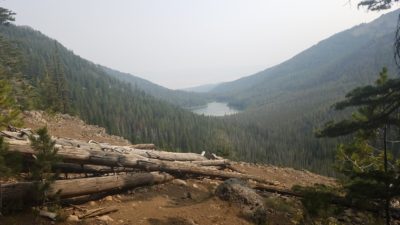
A view of Strawberry Lake from afar
I am embarrassed to say that prior to being 44, I had not backpacked. I’ve done tons of day hiking. A slew of car camping. And I have camped out in the woods for multiple days, at Rainbow Gatherings and when packing with llamas. But in the strict sense of the word backpacking, it took me a heck of a lot of years to get to it.
I had two obstacles. Zero desire to eat backpacking food. And lack of knowledge of how to proceed. Both of which are totally surmountable. And after spending two nights and three days trekking and exploring the Strawberry Mountains, a little known mountain range in Eastern Oregon, I am happy to say I feel prepared to do more. Furthermore, I am also willing to accept a modified diet for a few days at a time. Although I refuse to eat freeze dried meals.
So, on to my first backpacking trip.
Backpacking in the Strawberries!
Backpacking can be as easy or strenuous as you want to make it. Although when I say easy, it does still require a certain level of physical fitness, since you will be carrying your gear and walking at least a few miles a day.
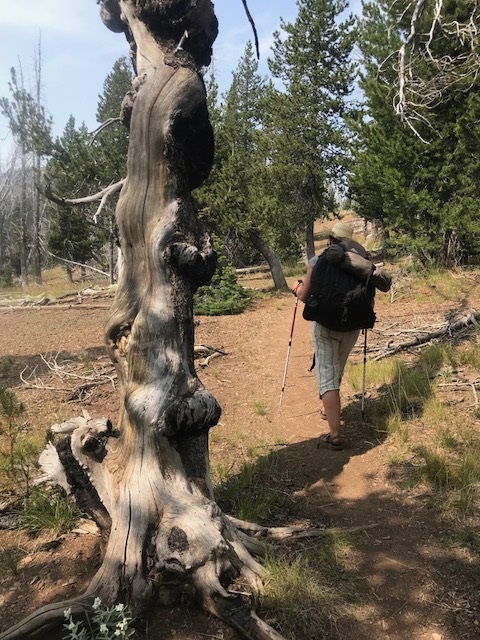 We did a 20-mile loop with a net elevation gain of about 3300 feet. Although the elevation figure can be deceiving. There were stretches that were a lot of up and down, some steep, some not. As is often the case, we did a lot more up and down than the net elevation figure implies. We entered late afternoon and walked four miles one day. Twelve miles the whole next day. And then got up early and covered the last four miles, reaching our car before noon.
We did a 20-mile loop with a net elevation gain of about 3300 feet. Although the elevation figure can be deceiving. There were stretches that were a lot of up and down, some steep, some not. As is often the case, we did a lot more up and down than the net elevation figure implies. We entered late afternoon and walked four miles one day. Twelve miles the whole next day. And then got up early and covered the last four miles, reaching our car before noon.
Our loop was the classic Strawberry Mountain Wilderness Loop. It certainly is not the only backpacking option of the region, but it covers a lot of the highlights. All other things being equal, I prefer a loop to an in and out trail, since it provides a greater variety of scenery. And while you can do the loop either way, I would suggest you go around Strawberry Lake at the beginning. This will mean you climb Strawberry Mountain toward the beginning of your second day, when you still have lots of energy.
Highlights of Exploring the Strawberry Mountains on the Classic Wilderness Loop
Sitting at Strawberry Lake
Strawberry Lake is reached only 1.2 miles in and you likely won’t need to stop because you are tired. But a spiritual rejuvenation watching the reflection in the lake is a worthy break.
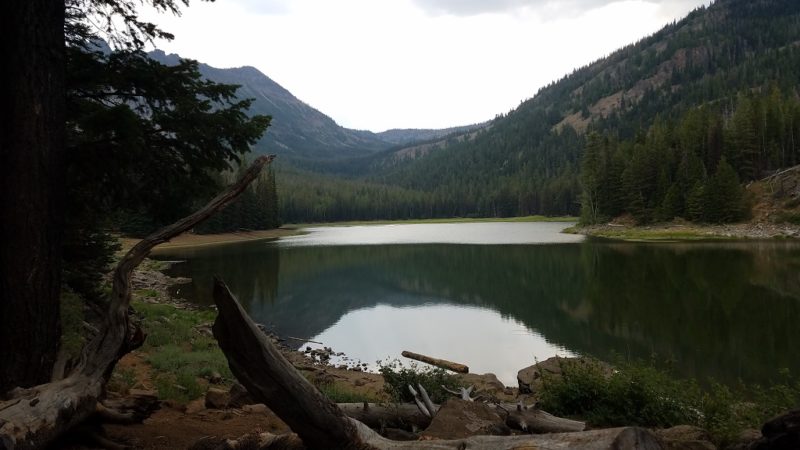
Tranquility is the reward for backpacking
Swimming in Strawberry Falls
Just 0.9 mile after Strawberry Lake, you come to the only waterfall on the hike. If the weather is warm, get in it! And if you don’t get in it, then use it as a photo op.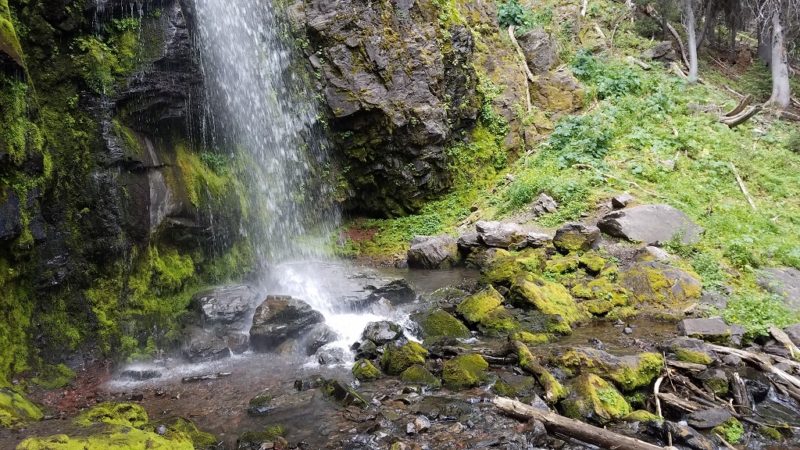
Little Strawberry Lake
Little Strawberry, about 4 miles in, made for a perfect camping spot on our first night. The lake is on a spur trail about 0.4 of a mile off the main trail. The solitude is wonderful, but the true wonders are the rocks. These rock walls that look as though they are suspended in space were formed by scouring glaciers in the last ice age. Splatters of lime green moss make the rocks come alive. In the distance and in the evening light, they were nothing short of breathtaking. I am sorry to say that I did not snap any photos in the evening, when the rocks were breathtakingly stunning. They were still very attractive in the morning, but the lighting was not prime for camera work. Here’s a pic taken in the morning.
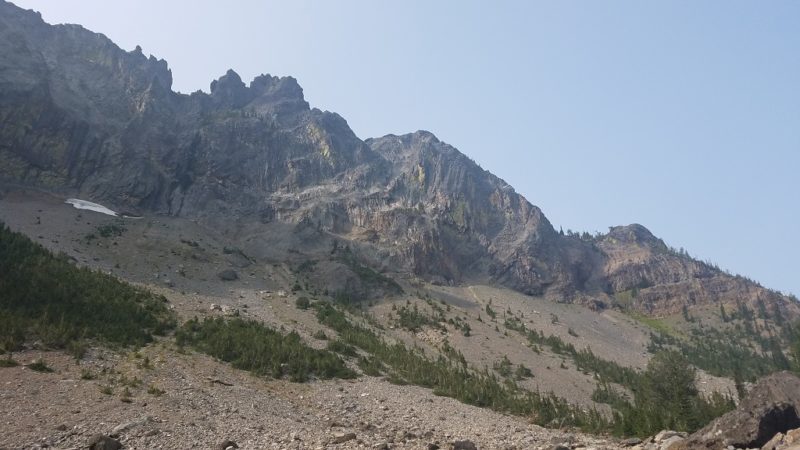
Sleeping at Little Strawberry Lake enclosed by hanging walls
Strawberry Mountain
We loved our camp at Little Strawberry, but if we had started our hike earlier in the day we might have camped at the base of Strawberry Mountain. It is on a 1.0 mile spur trail that switchbacks steeply to the namesake mountain. In case you are wondering, this is not prime real estate for growing strawberries. The rhyolite is a mineral that turns the rocks red, henceforth the loose resemblance to strawberries. We checked out the mountain and the views, but then kept moving on.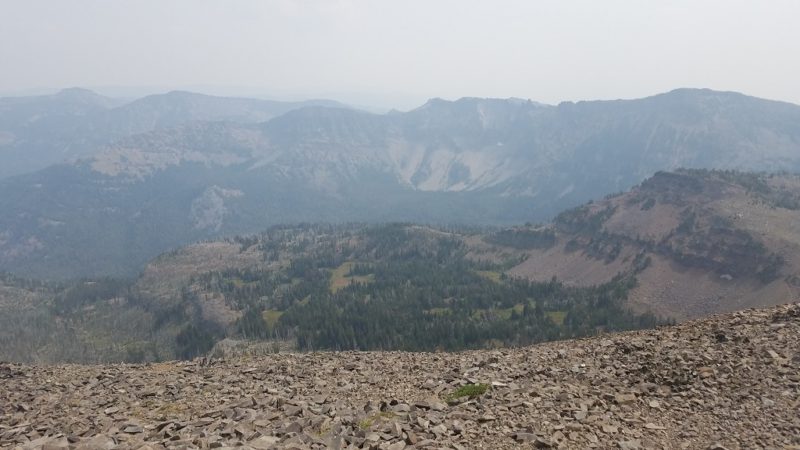
The Turnoff for Mud Lake
Note that the trail seemed to disappear here. The rest of the trail had been so well marked, it seemed out of place to not know where to go. We ended up going left, where it was all rocks and we could spot a trail in the distance. We did not go right into the woods. Although it looked like it might have been a more direct route, we did not want to take a chance of getting disoriented in the trees.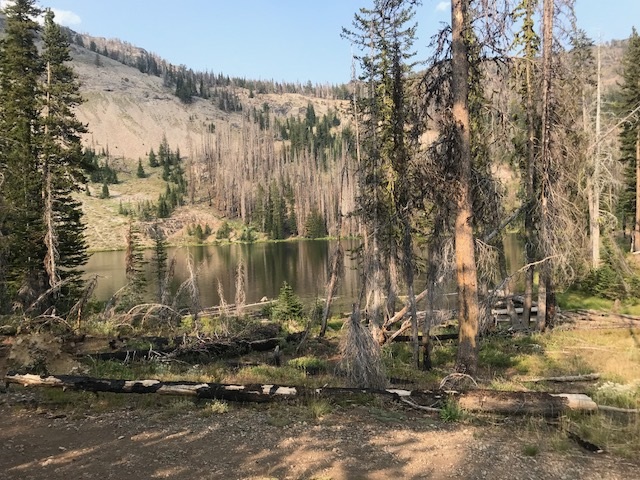
Slide Lake
Slide is another secluded lake off a spur trail that made a perfect campsite for our second night. Or you could use it the first night if you do the loop the opposite way. Like our other stops, the lake has beautiful hanging walls with rhyolite being the dominant rock.
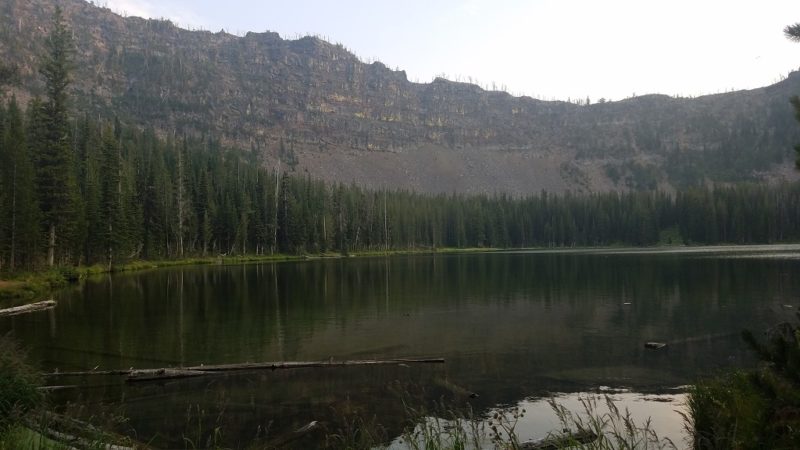
Look at those red rhyolite rock walls
The Mile and a Half after Slide Lake
This stretch that we did on our last morning ended up being the most challenging aspect of exploring the Strawberry Mountains. There were parts where the trail was thinly cut into the side of the steep mountain, with honestly little, if any room for error. It was at this point I became keenly aware that my shoes were low on tread. Some parts I needed to go at a grandma’s pace and lean into the mountain, utilizing my walking poles like a close friend in a time of need.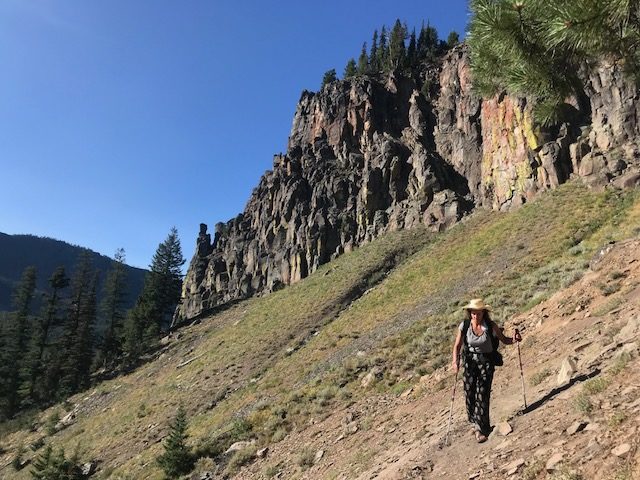
Viewpoints Along the Way
There are lots of spots to stand and admire what is before you, behind you, beside you, above you, below you, and all around you. I don’t honestly remember where they all are. There are some good ones between High Lake and Slide Lake. But since you are doing a fair bit of up and down, scenic opportunities abound. I am sure you will recognize them when you see them.
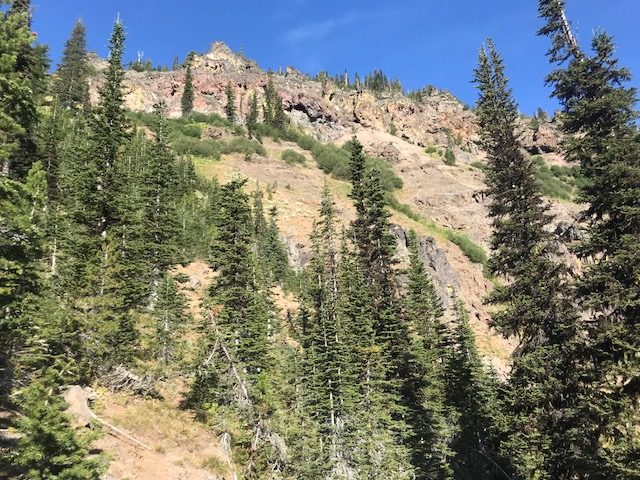
There is always time to take in an astonishing view
Takeaways from a Beginner’s First Backpacking Trip
Research trails and regions on the web
You can customize your trip to your abilities. The Outdoor Project website is a hikers dream come true. You need to join to have full access to the site, but it’s free.
Decide How Long to Make Your Trip
Decide how many miles you feel comfortable hiking a day and how many days you want to be on the trail. This will give you a range for how many miles you want to cover in your trip. It took us an average of 30 minutes a mile. This includes short stops for water and a photo ops. It does not include longer stops, like sitting atop a mountain, stretching out in a meadow and generally taking the time to relish the time and place.
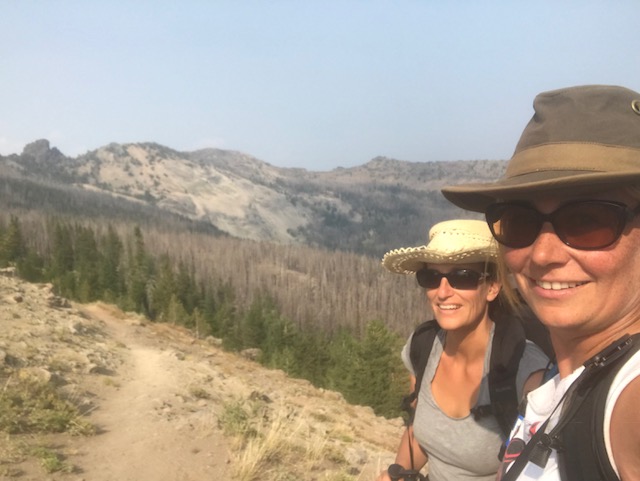
A novice should backpack with a friend
Consider Different Trail Styles
We did a loop, which offers the beauty of changing scenery. Another way to do it is to hike into a base camp (that can be 2-11 miles, or whatever you want it to be). Spend the first day getting to base camp and set up camp there. Then everything else is a day hike from there to nearby lakes, rivers, valleys, etc. You would only be carrying all your gear on your first and last day. I might do a base camp on my next trip. Obviously, there are lots of permutations. You should just figure out what is going to be the best fit for your adventure.
Test Your Carrying Capacity
Before you embark, make sure you can carry the weight of your gear. Lara and I strived for being minimalists on the trail. Sometimes you pass people weighted down like a mule. Carrying 80 pounds on my back sounds like no fun and my back and neck would agree. My pack weighed 30 pounds or less. I lift weights regularly, so I had no issues carrying my gear. But if you aren’t sure, practice some day hikes with your pack to build stamina.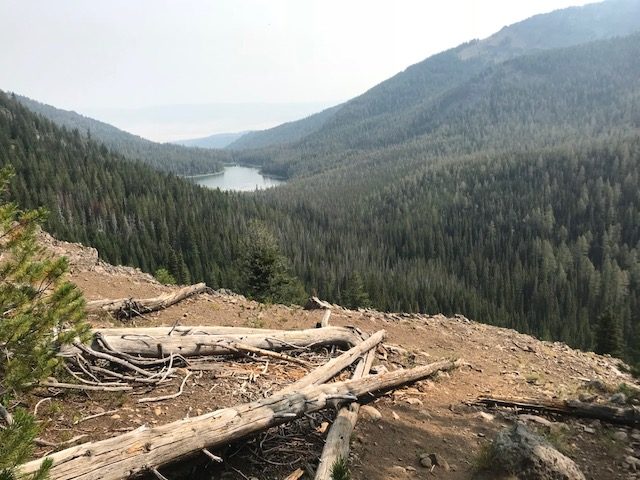
Pack Light!
Out of the mouth of a chronic over packer. I have friends who roar when I offer that bit of wisdom. But I assure you, I got serious about going lightweight. When you have to carry everything every step of your trip, you’ll be grateful you pared down.
Consider the Climate
The colder the climate, the more gear you need. But if it is too hot, you will be miserable hiking. I like it when the days are in the low 80’s and the nights cool off, but not below 55. Preferably in the 60’s. Time of year and elevation are predictable. How the weather gods might be feeling the week you are out, well that is up to chance. So always take good rain gear. Being a wet rat miles from the comforts of civilization is no fun.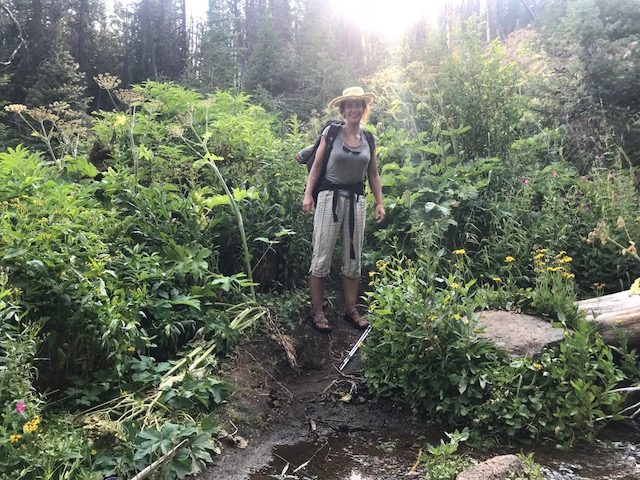
Purify Your Water
The days of being able to plop down and drink your fill from the gurgling stream in the wilderness are gone. You need to purify your water. Lara wore a CamelBak that held about two liters and had a water filter attached to it. I had a one quart Nalgene bottle and UV water filter. Both systems are legit, so pick one, or experiment. We passed streams regularly so water was abundant. But definitely research access to water before you go. No compromising here.
Pack It in, Pack It out
This is basic land stewardship logic, but unfortunately, is not always followed. Bring a gallon zip-lock bag for any garbage you may generate. This includes your used toilet paper. There is nothing grosser than going around a secluded corner in the wilderness and finding a field of toilet paper wads.
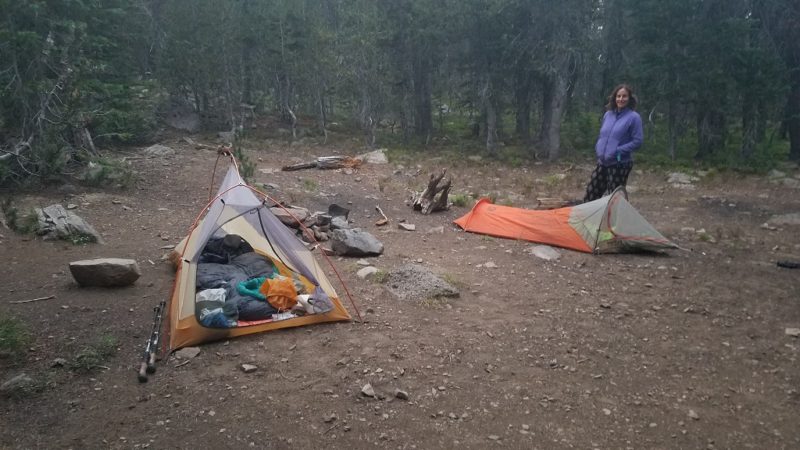
Paring down on gear is WISE
Choose Your Equipment Carefully
It stands to reason that the better quality your equipment is, the more expensive it is. This is certainly true for lightweight. What the gear lacks in weight, you pay upfront in cost. Then you reap the benefits of being more comfortable in your traveling. I have been accumulating gear over the years at REI and using it for all types of camping and travel. REI has sidewalk sales a couple times a year. Start slowly and eventually, you will be set up.
Eat Simply, but Well
Now that’s a big one, at least from the perspective of a foodie who has to be on rations for a few days. But I will keep it short by advising you to keep it simple.
I cook with a four ounce propane tank that holds with a single burner on top of it. If you are willing to carry the weight, you can bring a few veggies that stand up well in the heat. You’ll be eating like a queen for dinner, if you sauté some veggies. Filling out our diet for a few days were hard and semi-hard cheeses, charcuterie, dark chocolate (so it doesn’t melt), protein bars, and homemade trail mix. I also brought a little miso along so we could have the luxury of a cup of soup for breakfast and/or dinner.
We left some cheese, extra trail mix, and a big bottle of kombucha in the car, so as soon as we were off the trail, we had a fine snack waiting for us.
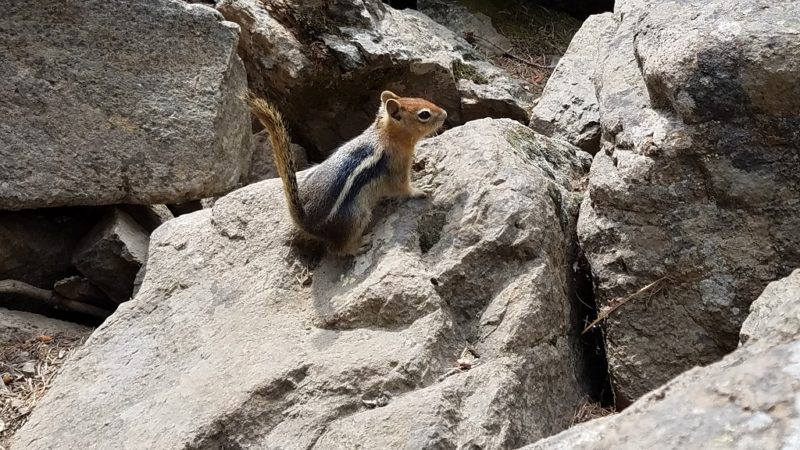
I love watching chipmunks
There’s lots to know and do to become a keen backpacker. I am still learning, but glad to be at it after those first 44 years. Here is my most basic wilderness wisdom. Start by going on an easy to moderate trail for a couple of days. Go with a friend or a group who can be your mentor. Practice awareness and mindfulness with respect to your surroundings. Educate yourself as to what dangers may exist (rattlesnakes, bears, etc). Tell someone where you will be and when you plan to return.
And most importantly, celebrate yourself for taking the time to commune with nature. And relish the entire experience!
To garner some ideas for checking out other parts of Eastern Oregon along with backpacking and exploring the Strawberry Mountains, click here.
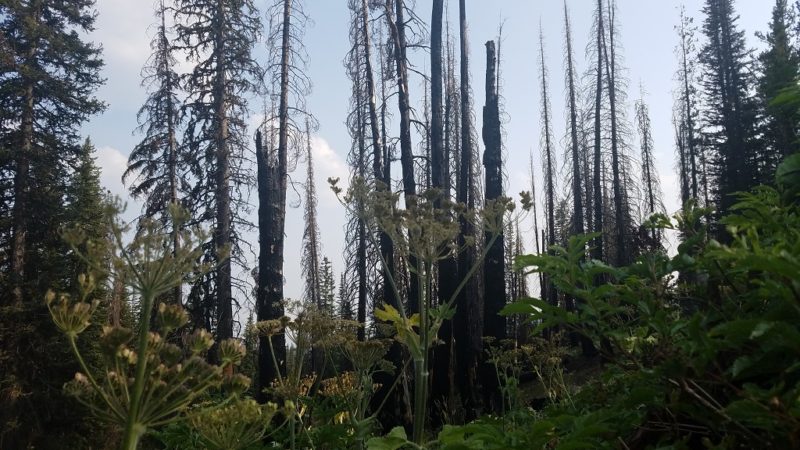
The Strawberry Mountain Wilderness Loop
